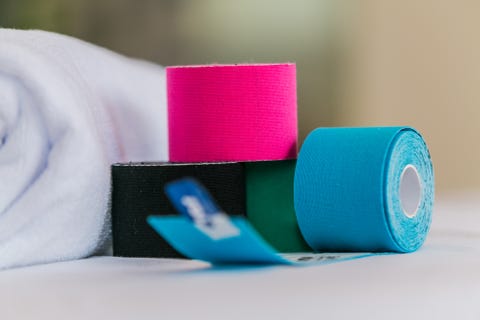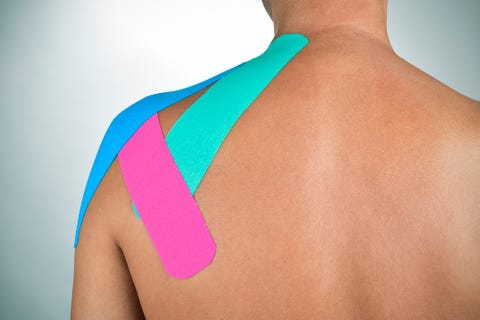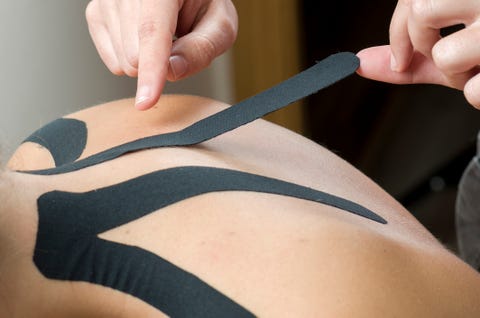
If you head to a Crossfit gym often, there’s a good chance that, at some point, you’ve seen somebody with what looks like colored scotch tape on a shoulder, or an elbow, or taped along the length of their thigh.
No, it’s not a fashion statement or the leftovers from a sixth-grade science project. It’s kinesiology tape (commonly called kinesio tape), and in recent years, it’s become a popular way to treat certain issues that will come up in the gym. And, increasingly, physical therapists and professionals are starting to accept it. The best part about kinesiology tape: You can often do it by yourself if you do it right.
What is Kinesiology Tape?
I first started using kinesiology tape way back in 2010, after working on the medical support team at the USA Track and Field Outdoor Championships. In theory, a physical therapist would tape along an athlete’s injured or inflamed muscles and fascia, and that would produce a microscopic lifting effect on the skin, decompressing the area. It would also slightly lift the fascia, increasing blood flow beneath the surface and upping the circulation of lymph fluid. This blood flow would, in theory, remove wastes and byproducts created by inflammation, speeding healing. There was also talk that the tape would affect pain receptors on the skin, interfering with pain signals to the brain.

Getty Imagesineer
Initially, both athletes and coaches were pretty skeptical about the new bright-colored tape that was making the rounds at training and medical facilities. But when I returned for the 2012 championships, that vibe had changed. Athletes and clinicians were hooked. Athletes swore that K-tape had decreased their pain and delayed fatigue during their runs, while clinicians spoke about the improved recovery times.
I now use it frequently in my own practice. If I can decompress an area to either aid in circulation or help with pain, I tape. Six years and more than 10,000 tapings later, I believe it does increase blood flow and improve circulation of lymph fluid, and decompress tissue.
Does Kinesiology Tape Work?
I’ve seen it work on a variety of occasions. It’s best used for musculoskeletal injuries, things like shoulder impingement, low back pain, and plantar fasciitis in your foot. In these instances, the tape seems to successfully dull my clients’ pain, allowing them to more easily do the physical therapy drills they need to achieve true healing.

Getty Imagesnito100
It doesn’t seem to work for everything though. If you’re dealing with a traumatic injury, such as a torn ACL or a serious rotator cuff tear, this won’t work a miracle. It can, however, help relieve some pain and remove wastes and byproducts caused by inflammation to those areas because of the injury.
Also, know that it’s not “healing” anything. It’s merely removing inflammation and allowing for better movement. You still need to do any rehab exercises you’re assigned.
How You Use Kinesiology Tape?
Applying kinesiology tape is easy. First, anchor the tape to one end of the muscle you’re aiming to loosen, then rub it down. Make sure the tape is tight. Further research is needed on the ideal tension length, but I believe it needs to be stretched to at least 50 percent tension before putting it down. There’s a lot of debate here, though. If you’re going to stick to my 50 percent rule, measure the muscle you’re taping, then use about half that amount of tape.

Getty ImagesSunlight19
Stretch the tape before you put it down on the muscle, so it can grab at the skin. Make sure you’re taping along the length of the muscle, too. So you wouldn’t tape, say, around your upper arm, since you’d simply catch some of the biceps and some of the triceps. You might, however tape down the length of your biceps from the shoulder to the elbow.
Leave the tape on for awhile. There’s debate over how long you need to leave it on, with some research stating it should be on for 24 hours and some saying you should leave it on for two weeks, but there’s little consensus at the moment. I try to have clients leave it on for four or five days. Remove it if it begins to irritate the skin.
Source: Read Full Article






